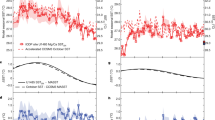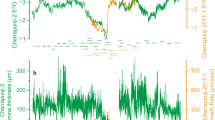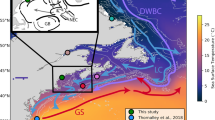Abstract
We agree with Zachos and colleagues that much can be learned about transient climate events from well-dated carbonate sediments from the deep ocean, and that the problem of recrystallization of such sediments (when tens of millions of years old) means that constraining relative temperature changes from oxygen-isotope data is more appropriate than attempting to measure absolute values.
Similar content being viewed by others
Pearson et al. reply
We note, however, that this marks a shift of emphasis from studies spanning several decades, in which attempts have been made to determine actual temperatures from the deep-sea record and to compare them with the output of climate-model simulations (for example, see refs 1–3). We also warn against assuming that “primary offsets in fossil shell chemistry tend to be preserved”, as diagenetic overprinting will tend markedly to reduce such offsets, as well as attenuating stratigraphic patterns.
We have suggested that recrystallization could account for as much as 50% of the mass of planktonic foraminifera in typical deep-sea samples, which would reduce estimated SSTs in the tropics by 10–15 °C. Zachos et al. have questioned our comparison of isotope data from well-preserved, middle-Eocene foraminifera from Tanzania and a recrystallized deep-sea assemblage. But we did not assume that initial conditions were identical for the two sites — indeed, we were careful to point out the likely original difference in temperature. When this is taken into account, we calculate that the oxygen-isotope data suggest a 55% diagenetic overprint of the deep-sea sample towards an ocean bottom-water temperature of about 10 °C (ref. 4). A similar overprint is also implied by the greatly reduced interspecies carbon-isotope differentials.
We also discussed the question of δ18Osw on the Tanzanian margin. For several reasons (the narrow open shelf, probable onshore current, normal stratification, full plankton assemblages and results of palaeosalinity modelling), we think it unlikely that the salinity was as much as 3.0 p.p.t. lower than in the deep ocean. But even if it were, the probable relationship between δ18Osw and salinity at this latitude would imply a δ18Osw value that is only about 0.5 p.p.t. more negative, which corresponds to an estimated temperature increase of about 2 °C. This is a small effect when compared with the apparent difference of nearly 15 °C in estimated SST between the East African shelf and coeval open-ocean sites such as ODP Site 865 (ref. 2). We stress that our Tanzanian data are also supported by similar results from Mexico, Alabama and the Adriatic Sea.
Study of both deep-sea carbonates and hemipelagic clays is crucial to ensure that sampling is as spatially distributed as possible. But there is no reason why hemipelagic mudstones should not be as accurately dated as deep-sea carbonates, thereby combining the advantages of high-resolution stratigraphy and good microfossil preservation. Recent Ocean Drilling Program (ODP) coring in New Jersey has already demonstrated this potential5, and we anticipate further well-dated Cretaceous and Palaeogene mudstones from a forthcoming ODP leg to Demerara Rise (in the equatorial Atlantic Ocean) and from our own drilling in Tanzania. Such investigations will help to elucidate past variation in absolute palaeotemperatures and meridional temperature gradients, which remains critical for testing the greenhouse theory for past warm climates.
References
D'Hondt, S. & Arthur, M. A. Science 271, 1838–1841 (1996).
Bralower, T. et al. Paleoceanography 10, 841–865 (1995).
Crowley, T. J. & Zachos, J. C. in Warm Climates in Earth History (eds Huber, B. T., MacLeod, K. S. & Wing, S. C.) 50–76 (Cambridge Univ. Press, Cambridge, 2000).
Oberhansli, H. & Toumarkine, M. in South Atlantic Paleoceanography (eds Hsu, K. J. & Weissert, H. J.) 125–148 (Cambridge Univ. Press, Cambridge, 1985).
Miller, K. G. et al. Proc. Ocean Drilling Prog., Init. Rep. vol. 174AX (Ocean Drilling Prog., College Station, Texas, 1998).
Author information
Authors and Affiliations
Corresponding author
Rights and permissions
About this article
Cite this article
Pearson, P., Ditchfield, P. & Shackleton, N. Tropical temperatures in greenhouse episodes. Nature 419, 898 (2002). https://doi.org/10.1038/419898a
Issue Date:
DOI: https://doi.org/10.1038/419898a
Comments
By submitting a comment you agree to abide by our Terms and Community Guidelines. If you find something abusive or that does not comply with our terms or guidelines please flag it as inappropriate.



